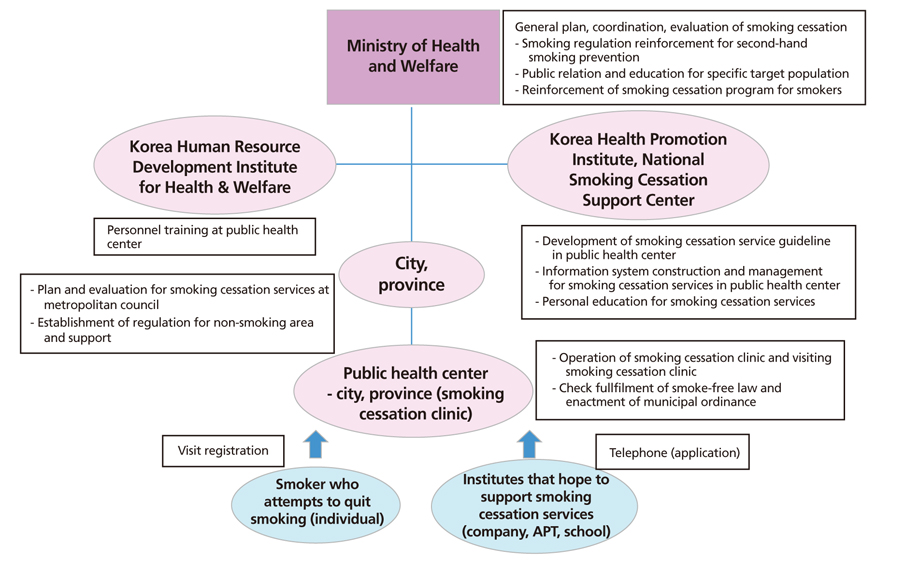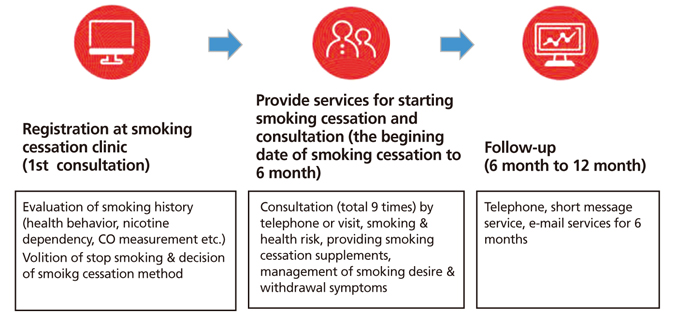J Korean Med Assoc.
2018 Mar;61(3):163-172. 10.5124/jkma.2018.61.3.163.
Smoking cessation services to which physicians can refer patients
- Affiliations
-
- 1Department of Cancer Control and Population Health, Graduate School of Cancer Science and Policy, National Cancer Center, Goyang, Korea.
- 2Division of Cancer Prevention, National Cancer Control Institute, National Cancer Center, Goyang, Korea.
- 3Department of Family Medicine & Supportive Care Center, Samsung Medical Center, Sungkyunkwan University School of Medicine, Seoul, Korea.
- 4School of Nursing, Shinhan University, Uijeongbu, Korea. september7777@hanmail.net
- KMID: 2406970
- DOI: http://doi.org/10.5124/jkma.2018.61.3.163
Abstract
- The purpose of this article is to introduce smoking cessation services in the community to which physicians can refer their patients. There are three types of services: smoking cessation clinics at public health centers, regional smoking cessation centers, and quitlines. Smoking cessation clinics were established in 2005 at public health centers to reduce the smoking rate. Tailored counseling, nicotine replacement therapy, and drug treatment can improve the success rate of smoking cessation in clinical settings, and behavioral therapy can promote smoking cessation in the community. Quitlines have been launched and operated throughout the world as effective cessation services that guarantee confidentiality, accessibility, convenience, and cost-effectiveness. Tailored information and intervention programs for smoking prevention and smoking cessation have been offered through the telephone, multimedia messaging services, social networking services, and chatting in Korea. Referrals from other national cessation programs for maintaining cessation are also available. Since 2015, regional smoking cessation centers have administered two types of camps. The target group of intensive-care smoking cessation camps includes heavy smokers, who should receive inpatient care at the regional smoking cessation center for 5 days. The general support smoking cessation camps target smokers who wish to quit or who have unsuccessfully quit, and provide education and consulting programs over 1 to 2 days. These three types of services provide different services and programs to smokers in the community. If physicians refer to their patients to these services, they may prove to be excellent resources for increasing smoking cessation.
MeSH Terms
Figure
Reference
-
1. Ministry of Health and Welfare. Korea Health Promotion Institute. A guide to community integration health promotion services in 2017: smoking cessation. Sejong: Ministry of Health and Welfare;2017.2. Ministry of Health and Welfare. Korea Health Promotion Institute. National smoking cessation support center: manual for consultation at smoking cessation clinic in public health center in 2015. Sejong: Ministry of Health and Welfare;2015.3. Ministry of Health and Welfare. Korea Health Promotion Institute, National Smoking Cessation Support Center. A guide to regional smoking cessation support centers in 2017. Sejong: Ministry of Health and Welfare;2017.4. Ministry of Health and Welfare. Korea Health Promotion Institute. A guide to community integration health promotion services in 2017: smoking cessation. Sejong: Ministry of Health and Welfare;2017.5. Stead LF, Lancaster T. Telephone counselling for smoking cessation. Cochrane Database Syst Rev. 2001; (2):CD002850.
Article6. Zhu SH, Anderson CM, Tedeschi GJ, Rosbrook B, Johnson CE, Byrd M, Gutierrez-Terrell E. Evidence of real-world effec-tiveness of a telephone quitline for smokers. N Engl J Med. 2002; 347:1087–1093.
Article7. World Health Organizaton. Developing and improving national toll-free tobacco quit line services: a World Health Organization manual [Internet]. Geneva: World Health Organizaton;2011. cited 2018 Feb 8. Available from: http://www.who.int/tobacco/publications/smoking_cessation/quit_lines_services/en/.8. Eriksen M, Mackay J, Schluger N, Islami F, Drope J. The toba-cco atlas. 5th ed. Atlanta: American Cancer Society;2015.9. North American Quitline Consortium. Quitline map [Internet]. Phoenix: North American Quitline Consortium;2017. cited 2018 Feb 8. Available from: https://naquitline.site-ym.com/?page=mappage.10. Willemsen MC, van der Meer RM, Bot S. Description, effec-tiveness, and client satisfaction of 9 European quitlines: results from the European Smoking Cessation Helplines Evaluation Project (ESCHER) [Internet]. Den Haag: STIVORO;2008. cited 2018 Feb 8. Available from: https://www.alliantienederlandrookvrij.nl/wp-content/uploads/2012/docs/rapporten/stoppenmetroken/ESCHER%20Final%20Report.pdf.11. Asian Pacific Quitline Network. APQN member profile [Internet]. Goyang: Asian Pacific Quitline Network;2017. cited 2018 Feb 8. Available from: http://apqn.or.kr.12. Ministry of Health and Welfare. National Cancer Center. The annual report on operation of quitline in Korea. Sejoung: Ministry of Health and Welfare;2017.
- Full Text Links
- Actions
-
Cited
- CITED
-
- Close
- Share
- Similar articles
-
- Attitudes toward Smoking Cessation Intervention and Services among Korean Physicians: A Questionnaire Survey
- Physicians' Perspectives on the Smoking Cessation Service for Inpatient Smokers
- Smoking Status and Smoking Cessation Activity among Physicians in a Community
- The Smoking Rate Among Doctors and Its Various Implications
- Smoking cessation services provided by the National Health Insurance Service




